2005 Hyundai Terracan engine coolant
[x] Cancel search: engine coolantPage 234 of 539
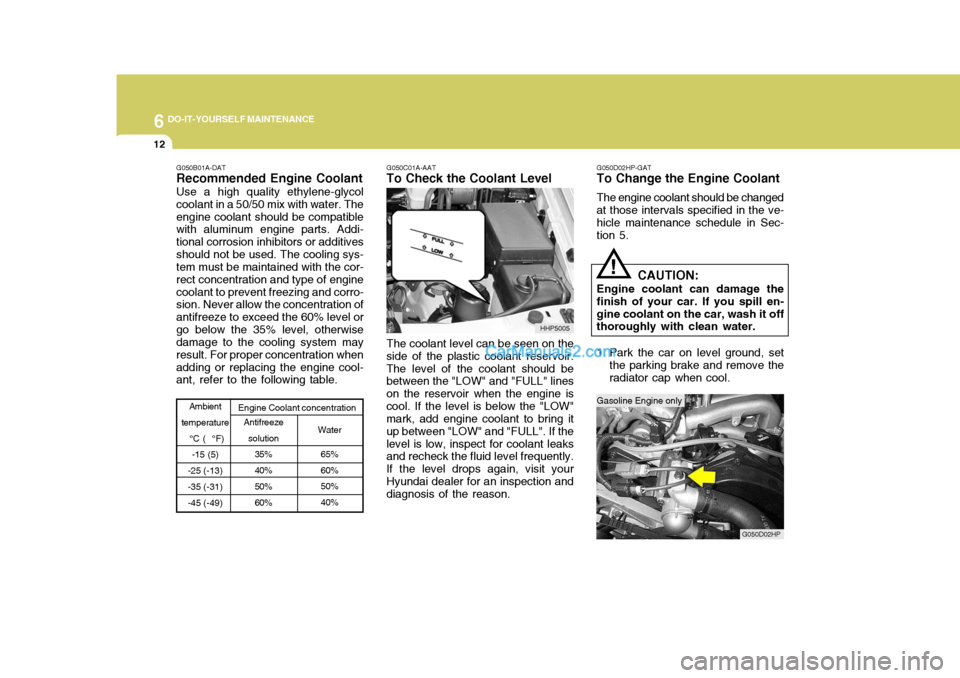
6 DO-IT-YOURSELF MAINTENANCE
12
!
Ambient
temperature
°C ( °F) -15 (5)
-25 (-13) -35 (-31) -45 (-49) Engine Coolant concentration
Water
65%60% 50% 40%
Antifreeze solution 35% 40% 50% 60%
G050C01A-AAT
To Check the Coolant Level
The coolant level can be seen on the
side of the plastic coolant reservoir. The level of the coolant should be between the "LOW" and "FULL" lines on the reservoir when the engine iscool. If the level is below the "LOW" mark, add engine coolant to bring it up between "LOW" and "FULL". If thelevel is low, inspect for coolant leaks and recheck the fluid level frequently. If the level drops again, visit yourHyundai dealer for an inspection and diagnosis of the reason. G050D02HP-GAT To Change the Engine Coolant The engine coolant should be changed at those intervals specified in the ve- hicle maintenance schedule in Sec- tion 5.
CAUTION:
Engine coolant can damage thefinish of your car. If you spill en-gine coolant on the car, wash it off thoroughly with clean water.
1. Park the car on level ground, set the parking brake and remove the radiator cap when cool.
G050B01A-DAT Recommended Engine Coolant Use a high quality ethylene-glycol coolant in a 50/50 mix with water. Theengine coolant should be compatible with aluminum engine parts. Addi- tional corrosion inhibitors or additivesshould not be used. The cooling sys- tem must be maintained with the cor- rect concentration and type of enginecoolant to prevent freezing and corro- sion. Never allow the concentration of antifreeze to exceed the 60% level orgo below the 35% level, otherwise damage to the cooling system may result. For proper concentration whenadding or replacing the engine cool- ant, refer to the following table.
HHP5005
G050D02HP
Gasoline Engine only
Page 235 of 539
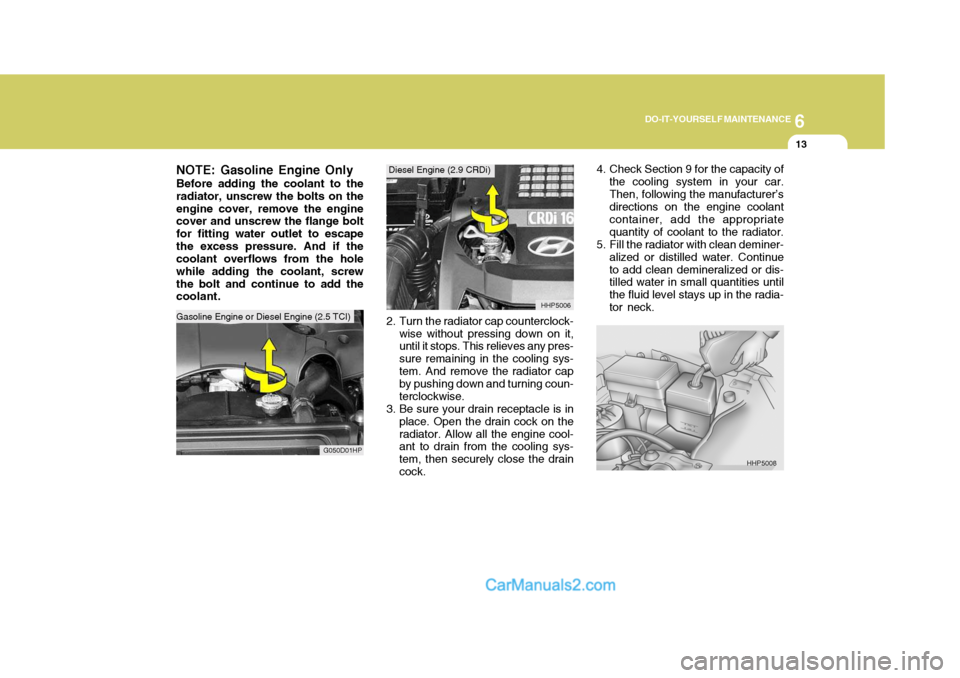
6
DO-IT-YOURSELF MAINTENANCE
13
NOTE: Gasoline Engine Only Before adding the coolant to the radiator, unscrew the bolts on theengine cover, remove the engine cover and unscrew the flange bolt for fitting water outlet to escapethe excess pressure. And if the coolant overflows from the hole while adding the coolant, screwthe bolt and continue to add the coolant.
G050D01HP 2. Turn the radiator cap counterclock-
wise without pressing down on it, until it stops. This relieves any pres- sure remaining in the cooling sys- tem. And remove the radiator cap by pushing down and turning coun-terclockwise.
3. Be sure your drain receptacle is in place. Open the drain cock on theradiator. Allow all the engine cool- ant to drain from the cooling sys- tem, then securely close the draincock. HHP5006
4. Check Section 9 for the capacity of
the cooling system in your car.Then, following the manufacturer’s directions on the engine coolant container, add the appropriatequantity of coolant to the radiator.
5. Fill the radiator with clean deminer-
alized or distilled water. Continueto add clean demineralized or dis- tilled water in small quantities until the fluid level stays up in the radia-tor neck.
HHP5008
Gasoline Engine or Diesel Engine (2.5 TCI) Diesel Engine (2.9 CRDi)
Gasoline Engine or Diesel Engine (2.5 TCI)
Page 236 of 539
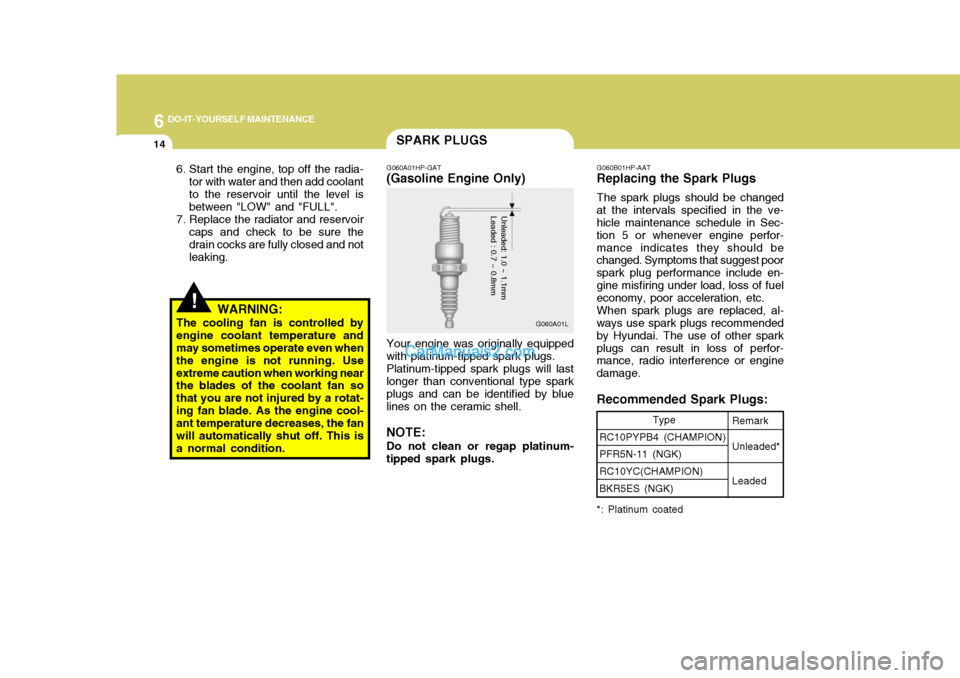
6 DO-IT-YOURSELF MAINTENANCE
14SPARK PLUGS
!
G060A01HP-GAT
(Gasoline Engine Only)
Your engine was originally equipped
with platinum-tipped spark plugs.
Platinum-tipped spark plugs will last
longer than conventional type spark plugs and can be identified by blue lines on the ceramic shell.
NOTE: Do not clean or regap platinum-
tipped spark plugs.
Unleaded: 1.0 ~ 1.1mm Leaded : 0.7 ~ 0.8mm
Type
RC10PYPB4 (CHAMPION) PFR5N-11 (NGK) RC10YC(CHAMPION)BKR5ES (NGK)
G060B01HP-AAT
Replacing the Spark Plugs
The spark plugs should be changed
at the intervals specified in the ve- hicle maintenance schedule in Sec- tion 5 or whenever engine perfor-mance indicates they should be changed. Symptoms that suggest poor spark plug performance include en-gine misfiring under load, loss of fuel economy, poor acceleration, etc.
When spark plugs are replaced, al-
ways use spark plugs recommended by Hyundai. The use of other sparkplugs can result in loss of perfor- mance, radio interference or engine damage. Recommended Spark Plugs:Remark Unleaded* Leaded
*: Platinum coated
6. Start the engine, top off the radia- tor with water and then add coolant to the reservoir until the level is between "LOW" and "FULL".
7. Replace the radiator and reservoir caps and check to be sure thedrain cocks are fully closed and not leaking.
WARNING:
The cooling fan is controlled byengine coolant temperature and may sometimes operate even when the engine is not running. Useextreme caution when working near the blades of the coolant fan so that you are not injured by a rotat-ing fan blade. As the engine cool- ant temperature decreases, the fan will automatically shut off. This isa normal condition. G060A01L
Page 244 of 539

6 DO-IT-YOURSELF MAINTENANCE
22CHECKING THE BRAKES
!
G120A01A-AAT
CAUTION:
Because brakes are essential to the safe operation of the car, it issuggested that they be checked and inspected by your Hyundai dealer. The brakes should bechecked and inspected for wear at those intervals specified in the vehicle maintenance schedule inSection 5.!!WARNING:
The cooling fan is controlled by engine coolant temperature and may sometimes operate even whenthe engine is not running. Use extreme caution when working near the blades of the cooling fan, sothat you are not injured by a rotat- ing fan blade. As the engine cool- ant temperature decreases, the fanwill automatically shut off. This is a normal condition. WARNING (Diesel only):
Never work on injection system
with engine running or within 30 seconds after shutting off engine. High pressure pump, rail, injec- tors and high pressure pipes aresubjected to high pressure even after the engine has been switched off. The fuel jet produced by fuelleaks may cause serious injury, if it contacts with the body. People using pacemakers should notmove closer than 30cm to the ECU or wiring harness within the en- gine room with the engine run-ning, since the high currents in the Common Rail system produce considerable magnetic fields.
Page 256 of 539

6 DO-IT-YOURSELF MAINTENANCE
34
Gasoline Engine or Diesel Engine (2.5 TCI)
POWER STEERING FLUID LEVEL
G220B01A-AAT
Checking Engine Cooling Fan
The engine cooling fan should come
on automatically if the engine coolant temperature is high.
G220C01A-AAT
Checking Condenser Cooling Fan
The condenser cooling fan should
come on automatically whenever the air conditioning is in operation. G230A03A-AAT The power steering fluid level should
be checked daily. G230A01HP
HHP5014CHECKING ELECTRIC COOLING FANS
!
G220A01A-AAT WARNING:
The cooling fan is controlled by engine coolant temperature and may sometimes operate even whenthe engine is not running. Use extreme caution when working near the blades of the cooling fan,so that you are not injured by a rotating fan blade. As the engine coolant temperature decreases thefan will automatically shut off. This is a normal condition.
Diesel Engine (2.9 CRDi)
Page 263 of 539
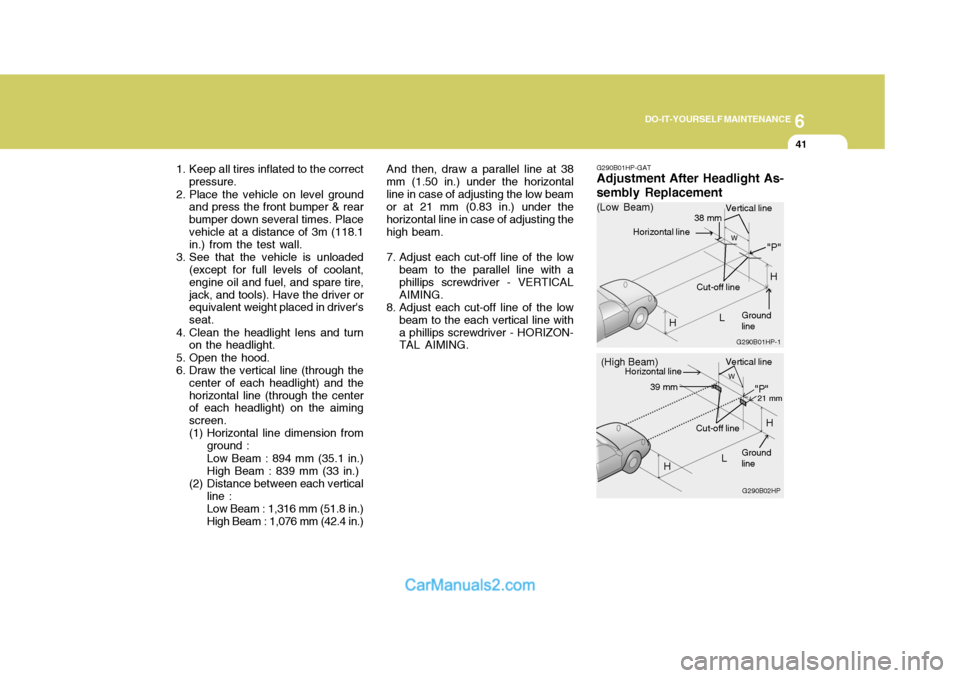
6
DO-IT-YOURSELF MAINTENANCE
41
1. Keep all tires inflated to the correct
pressure.
2. Place the vehicle on level ground and press the front bumper & rear bumper down several times. Placevehicle at a distance of 3m (118.1 in.) from the test wall.
3. See that the vehicle is unloaded (except for full levels of coolant, engine oil and fuel, and spare tire,jack, and tools). Have the driver or equivalent weight placed in driver's seat.
4. Clean the headlight lens and turn on the headlight.
5. Open the hood.
6. Draw the vertical line (through the center of each headlight) and thehorizontal line (through the center of each headlight) on the aiming screen.
(1) Horizontal line dimension from
ground : Low Beam : 894 mm (35.1 in.) High Beam : 839 mm (33 in.)
(2) Distance between each vertical line : Low Beam : 1,316 mm (51.8 in.) High Beam : 1,076 mm (42.4 in.) And then, draw a parallel line at 38
mm (1.50 in.) under the horizontalline in case of adjusting the low beam or at 21 mm (0.83 in.) under the horizontal line in case of adjusting thehigh beam.
7. Adjust each cut-off line of the low beam to the parallel line with a phillips screwdriver - VERTICALAIMING.
8. Adjust each cut-off line of the low beam to the each vertical line witha phillips screwdriver - HORIZON- TAL AIMING. G290B01HP-GAT Adjustment After Headlight As- sembly Replacement
G290B02HP
LW
H Cut-off line
"P"
Vertical line
Horizontal line
Ground line
21 mm39 mm
(High Beam)
H
G290B01HP-1
LW
"P"
38 mm
H
H
(Low Beam)
Vertical line
Ground line
Cut-off line
Horizontal line
Page 272 of 539
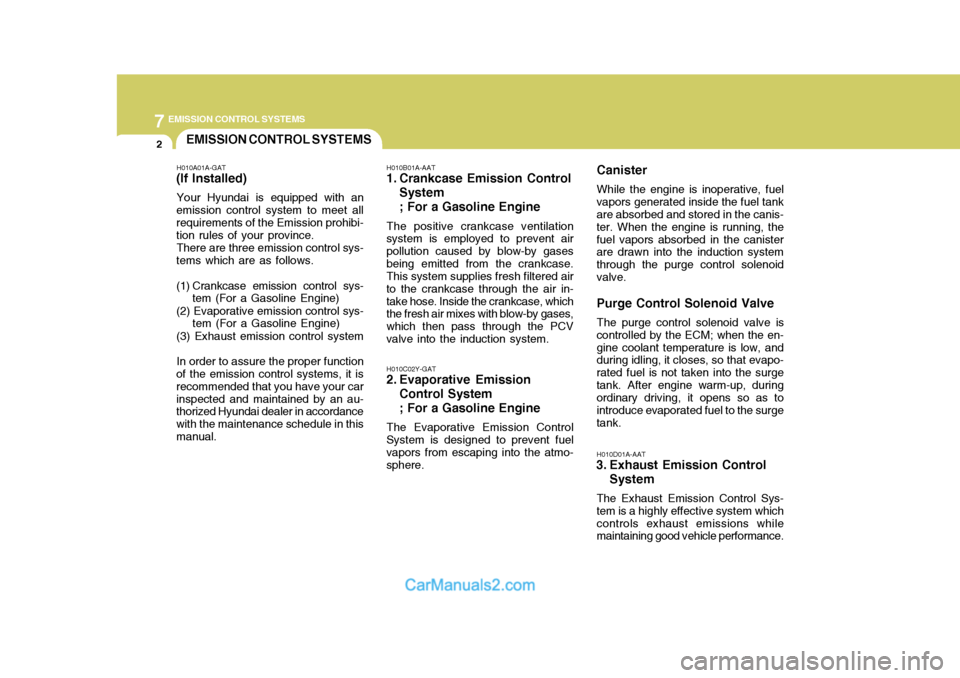
7EMISSION CONTROL SYSTEMS
2EMISSION CONTROL SYSTEMS
H010A01A-GAT
(If Installed)
Your Hyundai is equipped with an
emission control system to meet all requirements of the Emission prohibi- tion rules of your province.
There are three emission control sys-
tems which are as follows.
(1) Crankcase emission control sys- tem (For a Gasoline Engine)
(2) Evaporative emission control sys- tem (For a Gasoline Engine)
(3) Exhaust emission control system
In order to assure the proper function
of the emission control systems, it is recommended that you have your carinspected and maintained by an au- thorized Hyundai dealer in accordance with the maintenance schedule in thismanual. H010B01A-AAT
1. Crankcase Emission Control
System ; For a Gasoline Engine
The positive crankcase ventilation
system is employed to prevent air pollution caused by blow-by gasesbeing emitted from the crankcase. This system supplies fresh filtered air to the crankcase through the air in-take hose. Inside the crankcase, which the fresh air mixes with blow-by gases, which then pass through the PCVvalve into the induction system.
H010C02Y-GAT
2. Evaporative Emission
Control System ; For a Gasoline Engine
The Evaporative Emission Control
System is designed to prevent fuel vapors from escaping into the atmo- sphere. Canister
While the engine is inoperative, fuel
vapors generated inside the fuel tankare absorbed and stored in the canis- ter. When the engine is running, thefuel vapors absorbed in the canister are drawn into the induction system through the purge control solenoidvalve. Purge Control Solenoid Valve
The purge control solenoid valve is
controlled by the ECM; when the en- gine coolant temperature is low, and during idling, it closes, so that evapo- rated fuel is not taken into the surgetank. After engine warm-up, during ordinary driving, it opens so as to introduce evaporated fuel to the surgetank. H010D01A-AAT
3. Exhaust Emission Control
System
The Exhaust Emission Control Sys- tem is a highly effective system whichcontrols exhaust emissions while maintaining good vehicle performance.
Page 290 of 539

10
INDEX
3
Corrosion protection Cleaning the interior ................................................. 4-6
Protecting your Hyundai from corrosion .................. 4-2
Washing and waxing ................................................ 4-4
Cruise Control ......................................................... 1-100
D Defrosting/Defogging ............................................... 1-109
Door
Locking and unlocking front door with a key ........1-11
Drink Holder .............................................................. 1-82
Drive Belts ...................................................... 6-25, 6-29
Driving
Driving for econom y ............................................... 2-23
Smooth cornering ................................................... 2-25
Winter driving ......................................................... 2-25
E Emission Control Syst em ........................................... 7-1
Catalytic converter ................................................... 7-3
EGR System ............................................................ 7-5
Engine Before starting the engine ....................................... 2-3 Compartment (3.5 V6) ............................................. 6-2
Compartment (2.5 TCI) ............................................ 6-3
Compartment (2.9 CRDi) ......................................... 6-4 Coolant ................................................................... 6-11
Coolant temper ature gauge ................................... 1-65If the engine
overheats ............................................ 3-4
Number .................................................................... 8-2
Oil ............................................................................. 6-6
Starting ..................................................................... 2-5
Engine Exhaust Can Be Dangerous ........................... 2-2
FFan Speed Control ...................................... 1-104, 1-115
Fog Light Switch
Front ....................................................................... 1-75
Rear ....................................................................... 1-75
Four-Wheel Drive (4WD) ........... ............................... 2-14
Front Seats
Adjustable front seats ............................................ 1-18
Adjustable headrest s .............................................. 1-19
Adjusting seat forward and rear ward..................... 1-18
Adjusting seatback angle .......................................1-19
Front/Rear Window Defroster Sw itch....................... 1-78
Fuel
Capacity ................................................................... 9-2
Diesel ....................................................................... 1-2
Gauge .................................................................... 1-65
Unleaded gasolin e ................................................... 1-2
Fuel Filler Lid Remote release ...................................................... 1-96
Full-time 4WD Operation ............... ........................... 2-17
Fuses ........................................................................ 6-30